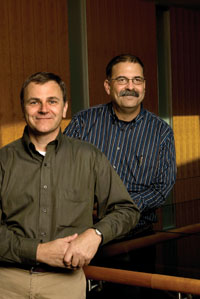
Scott Baldwin, M.D., right, and Joey Barnett, Ph.D. (photo by Stu Rosner)
Consortium’s goal: develop new ways to generate organs
If Vanderbilt scientists have their way, it will one day be possible to grow replacement heart valves from a patient's own stem cells.
That's one goal of a new interdisciplinary consortium that aims to develop a systematic method for generating new organs and organ parts. In addition to heart valves, the group will focus on growing pancreatic islets and teeth in the lab.
The Systems-based Consortium for Organ Design and Engineering (SysCODE) is part of a recently funded National Institutes of Health “Roadmap” initiative that is designed to speed the movement of scientific discoveries from the bench to the bedside.
“This initiative brings together teams of developmental biologists, bioengineers, cell biologists, experts in computational and genome science, and systems biologists to focus on difficult problems that none of the individual groups have been able to solve on their own,” commented Scott Baldwin, M.D., the principal investigator for the Vanderbilt team.
“We've been studying cardiac development — and thinking about how we can use our knowledge to develop something for patients — for a long time,” said Joey Barnett, Ph.D., co-principal investigator of the heart valve project. “Now we have both the charge and the resources to make our best effort to make it happen.”
SysCODE, which was awarded $24 million over five years, includes premier laboratories and investigators from Harvard and its affiliated hospitals, MIT, and Boston University.
The Vanderbilt team is the only group of investigators involved from outside of the Boston area. Richard Maas, M.D., Ph.D., chief of the Division of Genetics at Brigham and Women's Hospital, and a graduate of Vanderbilt's School of Medicine and Pharmacology Training Program, is the overall principal investigator of SysCODE.
The premise of the consortium program, explained Baldwin, is that development follows a “blueprint” for forming complicated organs from a single cell type. It's up to the investigators to decipher this blueprint — determine which genes are the essential ones — and use that information to push the appropriate stem cell populations to form heart valves, teeth or pancreas.
“We're going to figure out every gene involved in each of those developmental programs … it's an outrageous hypothesis,” Baldwin said.
“What we predict is that we'll find some common pathways in organs as diverse as a tooth, a pancreas and a heart valve,” added Barnett.
In addition to identifying the development-guiding gene networks, the investigators will be defining the material between the cells.
“If you look at a heart valve, it's mostly not cells; it's mostly extracellular matrix,” Barnett said.
Richard Caprioli, Ph.D., director of the Mass Spectrometry Center, will lead proteomic efforts to “figure out what's between the cells, what the steel girder construction of that building looks like,” Barnett said. Tissue engineers in Boston will use this information to build the “scaffolding” for a heart valve.
The consortium approach — with scientists from so many different disciplines all sharing ideas and data — represents a “paradigm shift” in how science is done, and is critical to solving problems like organ engineering, Baldwin said.
Heart valve problems have become “epidemic,” Baldwin said. One in 100 children is born with congenital heart disease, which can include valve problems that necessitate multiple surgeries to accommodate growth. In older adults, valve repair and replacement surgeries now outnumber coronary artery bypass surgeries.
“In both young and old patients, if we had a durable valve product that doesn't require anti-coagulation or replacement, that would be huge,” Barnett said.
He envisions the day when “if you need a valve, we can take your circulating or bone marrow-derived stem cells, have the tissue engineers sculpt the right shape and size matrix, grow the cells on the matrix, and give the complete heart valve to the surgeon.
“Wouldn't that be amazing?”
Baldwin is professor of Pediatrics and chief of Pediatric Cardiology, and Barnett is associate professor of Pharmacology and Medicine.













